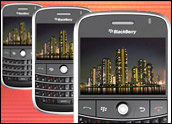
Research In Motion (RIM) and AT&T finally put the much-delayed BlackBerry Bold on store shelves Tuesday.
The device, aimed at corporate and business users, offers international wireless coverage with global 3G capabilities, built-in GPS, WiFi and access to thousands of services and applications available from AT&T’s consumer and business application developers.
The phone, exclusively available through AT&T, had been held up for undisclosed reasons for several months following its initial unveiling in May.
“I am glad that the Bold is out, but based upon what is immediately available, it should not have been held up. It looks to me that its hold-up was mostly administrative within AT&T,” Bill Hughes, an In-Stat analyst, told TechNewsWorld.
The highly anticipated smartphone will be available for US$299.99 with a two-year voice plan contract of at least $39.99 per month. Unlimited data plans start at an additional $30, with access to BlackBerry Professional Software or Enterprise Server and access to corporate e-mail available for an additional $45.
Boldly Going
The BlackBerry Bold represents the evolution of the handset line, Michael Gartenberg, vice president of Mobile Strategy at Jupitermedia/Mobiledevicestoday.com, told TechNewsWorld.
“Everything you had on the BlackBerry so far — this is the best incarnation of that. It has the best keyboard. It has the best screen. The best media features. It’s much faster in terms of overall performance because of updates to the operating system. And, of course, much faster because its operating on AT&T’s 3G network,” he said.
All those feature combine with the “real nice job” RIM has done with the design and aesthetics, including the leatherette covered back, Gartenberg pointed out.
“It looks like a BlackBerry, feels like a BlackBerry and has a more elegant feel. If you’re a traditional BlackBerry user, this is simply your next logical upgrade. You’re not looking at an Android. They’re not looking at an iPhone or other devices. You really want that core BlackBerry experience, and this is a great next step in that experience going forward, including improved Web browsing experiences, better screen, better keyboard, better battery and all that stuff,” he continued.
Facing the Competition
The Bold, according to Hughes, is opening up greater imaging capabilities to the BlackBerry ecosystem.
“That does not immediately result in big changes. It takes time for the ecosystem to catch up. In the mean time, it is mostly just nicer packaging than the 8820. This is nothing to ignore. Nice packaging is very important. At the same time, it is not compelling. Mostly, this product will stand out among those looking for a BlackBerry. The screen is really nice,” he explained.
In an increasingly crowded market where the touchscreen has risen sharply in popularity, Hughes does not see the Bold as a threat to the G1 or the iPhone.
“The Bold complements the BlackBerry product line-up. BlackBerry has more ‘shelf space,’ to use a grocery store analogy. There is a wide range of options from entry level to high-end. This adds to the merchandising for RIM overall. In contrast, if you want an Android phone, you must get a G1. If you want an Apple, you must get an iPhone 3G. The advantage goes to RIM unless someone specifically want a particular device,” he pointed out.
The Bold is RIM’s first 3G BlackBerry device for AT&T, and the carrier will win some subscribers with the Bold who cannot wait for the upcoming Storm touchscreen smartphone from RIM to launch on the Verizon network, said Chris Hazelton, an analyst at The 451 Group.
“Once you have Storm and Bold, that will serve to lessen the appeal of Bold, but not for traditional BlackBerry users. Storm really targets the touchscreen crowd,” he told TechNewsWorld.
Along with the Bold and Storm, RIM has expanded its lineup over the past two years with the debut of the the BlackBerry Pearl, the BlackBerry Pearl Flip and the BlackBerry Curve. All those models give RIM and its network carriers more choice for users in a market where enterprise users are demanding greater diversity and functionality in their devices.
“With Bold and Storm, you have two higher-end devices for users that want to differentiate themselves from the crowd. Bold allows users to differentiate themselves from other BlackBerry users,” Hazelton noted.




















































